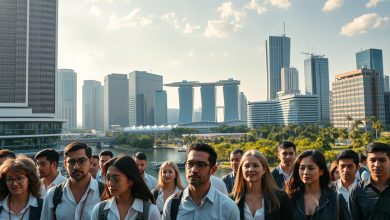Visa Sponsorship in Italy: Unlock the Benefits
Anúncios
For professionals seeking international work experiences, Italy offers unique pathways to combine career growth with cultural immersion.
Navigating the country’s immigration system requires understanding how sponsorship programs operate and which options align with individual goals.
Sponsored visas enable foreign nationals to access Italy’s job market while complying with local regulations. Opportunities range from skilled employment roles to entrepreneurial ventures, each requiring collaboration with approved organizations. Eligibility often depends on factors like professional qualifications, employer partnerships, or family connections.
Key advantages include streamlined access to EU member states and social benefits comparable to Italian citizens. Many applicants also discover pathways toward long-term residency after meeting specific criteria. Proper preparation ensures applicants avoid common pitfalls during documentation and approval stages.
This guide breaks down critical steps for securing sponsorship, from identifying qualifying roles to submitting error-free applications. Readers will learn how to leverage Italy’s policies to turn temporary opportunities into lasting professional foundations.
Understanding Visa Sponsorship Italy
Securing authorization to live and work abroad involves navigating two primary pathways under Italian law. Long-term permits fall into in-quota or extra-quota categories. The former operates under annual limits set by the Flow Decree, a government policy regulating foreign labor entry. The latter has no caps, offering flexibility for specialized roles or family reunification.
Sponsors—employers, schools, or relatives—must prove financial stability and legal compliance. “This system balances national workforce needs with opportunities for skilled individuals,” notes an immigration expert. Applications depend on timely documentation from both parties, including proof of accommodation and employment contracts.
Key benefits for foreign nationals include:
- Priority processing for extra-quota cases
- Access to healthcare and education services
- Potential pathways to permanent residency
Understanding these distinctions helps applicants choose suitable options based on their qualifications and timelines. Proper preparation reduces delays during the approval stages, ensuring smoother transitions into Italian professional networks.
Overview of Italian Work Visas and Residence Permits
Navigating Italy’s immigration framework starts with understanding two core categories: temporary entry permits and extended authorization pathways. Choosing the right option depends on an applicant’s goals, from brief assignments to multi-year career plans.
National vs. Schengen Visas
National Visas (Type D) act as gateways for stays exceeding 90 days. These long-term authorizations allow holders to apply for residence permits after arrival. In contrast, Schengen Visas (Type C) limit visits to 90 days within a 180-day window and don’t permit residency applications. Travelers using short-term options cannot legally work without additional approvals.
Long-Term and Short-Term Permit Options
Initial work permits typically last six months to two years, depending on employment contracts. Extended stays require renewal or conversion to permanent status after five continuous years. Temporary solutions include:
- Seasonal permits for agriculture or tourism roles
- Project-based contracts with fixed end dates
- Intra-company transfers under specific agreements
Long-term residency unlocks benefits like unrestricted employment and EU mobility. Experts emphasize selecting the correct permit type early, as initial choices impact future eligibility for renewals or permanent status.
Exploring Different Visa Categories in Italy
Foreign nationals considering extended stays in Europe often discover diverse pathways tailored to their unique circumstances. From financial independence to academic pursuits, each authorization type serves distinct purposes while aligning with local regulations.
Elective Residency and Investment Visas
Individuals with stable passive income may qualify for elective residency permits. These require proof of sufficient funds—typically €38,000+ annually—and comprehensive health coverage. “This option appeals to retirees and remote workers seeking Mediterranean lifestyles without local employment,” explains a relocation consultant.
Investment-based permits target business-minded applicants. Requirements include:
- Minimum €500,000 in Italian startups or government bonds
- Detailed business plans for entrepreneurial ventures
- Job creation commitments for certain industries
Work, Study, and Family Reunification Visas
Employment permits vary by sector and duration. Common subcategories include:
- Seasonal contracts for agriculture/tourism
- Specialized roles requiring advanced degrees
- Corporate transfers within multinational companies
Student authorizations allow 20-hour weekly work alongside academic programs. Graduates from Italian universities often transition to full-time work permits. Family-based applications enable spouses, children, and dependent parents to join residents through streamlined processes.
Preparing Your Application for a Sponsored Visa
Organizing paperwork with precision separates successful applicants from those facing delays. Start by reviewing official checklists from Italian consulates to avoid missing critical items. Cross-verifying dates, signatures, and formatting specifications ensures every detail aligns with regulations.
Gathering Required Documents
Essential materials fall into three categories: identification, employment proof, and financial stability. A valid passport must have two blank pages and remain active for three months post-visa expiration. Work-related submissions require:
- Original Nulla Osta authorization plus a copy
- Signed employment contract specifying role and duration
- Diplomas or certificates validating job qualifications
Proof of accommodation—like rental agreements or sponsor letters—and international health coverage round out core requirements. “Submitting incomplete files remains the top reason for rejections,” states a Rome-based immigration attorney.
Tips for a Complete and Successful Submission
Arrange documents in the exact order specified by consulates to streamline processing. Certified translations of non-Italian materials prevent administrative hiccups. Double-check that photos meet size and background guidelines—even minor deviations cause setbacks.
Applicants should schedule appointments early and confirm fee payment receipts. Professional legal reviews catch oversights like expired bank statements or unsigned forms. Keeping digital backups of every file simplifies corrections if updates arise during review periods.
Key Eligibility Requirements and Required Documents
Non-EU nationals aiming to reside in Italy must navigate a series of strict eligibility conditions outlined in local laws. These rules ensure applicants contribute positively to the economy or society while maintaining legal compliance. Each pathway has unique criteria, from family ties to financial investments.
Ensuring You Meet All Legal Criteria
Family-based applications require documented proof of relationships, such as marriage certificates or birth records. Educational candidates must show enrollment confirmations and financial stability for tuition and living costs. Employment seekers need valid job offers with contracts meeting local salary standards.
Corporate applicants must prove active roles in companies operating for three+ years. Investment pathways demand detailed business plans and minimum funds: €50,000 for startups or €250,000 for existing firms. Self-employed individuals need viable business concepts and resource proof.
Elective residency applicants must demonstrate passive income exceeding €32,000 annually. “Thorough documentation prevents delays,” advises a Milan immigration consultant. All submissions require certified translations and notarized copies to meet consulate expectations.
Required documents often include:
- Valid passport with blank pages
- Employment contracts signed by Italian employers
- Bank statements showing financial capacity
Post office appointments finalize submissions after gathering paperwork. Meeting these requirements streamlines approval for long-term opportunities.
Navigating the In-Quota and Extra Quota Visa Process
Annual numerical restrictions shape opportunities for foreign workers seeking authorization. The system divides available permits into two groups: those with fixed annual limits (in-quota) and unrestricted options (extra-quota). Strategic planning becomes essential when targeting capped categories.
Understanding the Flow Decree
The Decreto Flussi determines how many in-quota permits the Italian government allocates yearly across employment sectors. Updated in January 2023, it expanded available work permits by 18% to address labor shortages. “This adjustment reflects shifting economic priorities,” remarks a Bologna-based immigration attorney.
Handling Quota Limitations Effectively
Applicants face three critical challenges with capped permits:
- Seasonal roles often fill quotas within weeks
- Documentation errors cause instant rejections
- Delayed submissions risk missing annual windows
Extra-quota alternatives provide flexibility for skilled professionals or family-based cases. Legal advisors recommend monitoring official portals for quota openings and preparing applications months in advance. Those missing deadlines can explore study permits or investment pathways as backup solutions.
Successful Strategies for Visa Interview and Documentation
Mastering the final stages of the authorization process demands attention to both paperwork precision and interpersonal skills. Applicants often underestimate how interview dynamics influence outcomes, even with flawless documentation. A strategic approach combines thorough preparation with clear communication to showcase eligibility.
Interview Preparation and Communication Tips
Consular officers assess authenticity through verbal responses and body language. Work visa candidates should practice explaining their roles using industry-specific terms while avoiding jargon. For example: “I’ll manage cross-border logistics to streamline supplier networks” demonstrates clarity better than vague statements.
Key steps for success include:
- Reviewing employment contracts to discuss salary, duties, and timelines confidently
- Researching regional labor demands to align answers with local economic needs
- Preparing translated copies of diplomas or certifications for quick verification
Professional attire and punctuality signal respect for the process. Applicants should anticipate questions about long-term plans without overpromising permanent relocation. Language barriers? Bring a certified translator if fluency falls short.
Carry originals of all submitted documents, including bank statements and accommodation proofs. One immigration advisor notes: “Officers appreciate organized files—it reflects reliability.” Transparency about past rejections or travel history builds trust faster than evasive answers.
Comprehensive Guide to Italian Administrative Procedures
Finalizing residency authorization involves mastering local administrative steps. Timely submissions and understanding bureaucratic workflows prevent delays in securing legal status.
The Role of the Yellow Kit (Permesso di Soggiorno Kit)
The Yellow Kit streamlines applications for non-EU nationals. This postal package contains multilingual forms, payment slips, and instructions for the permesso di soggiorno. Applicants must visit designated post offices within eight working days to submit their completed kit.
Staff verify documents and schedule mandatory police station appointments. Missing deadlines risks penalties or delayed processing. Always request a receipt as temporary proof of legal residency.
Booking and Attending Appointments at the Post Office
High demand requires booking post office slots weeks in advance. Bring originals of all documents submitted in the Yellow Kit, including passports and housing contracts. Arrive early to avoid missed time windows.
Post offices serve as hubs for initial paperwork reviews. Staff guide applicants through fee payments and checklist confirmations. Delays often occur if forms lack signatures or translations—double-check every detail beforehand.
For more information, explore the official visa website mentioned in this article:
You will be redirected to another website
FAQ
What distinguishes a national visa from a Schengen visa?
A Schengen visa allows stays up to 90 days for tourism or business. National visas are for longer stays, such as employment or study, requiring a residence permit after arrival.
How long does a permesso di soggiorno last for work purposes?
Work-related residence permits vary. Short-term options cover seasonal roles (up to 9 months), while long-term permits may extend up to two years, renewable based on employment contracts.
Can foreign investors apply for elective residency visas?
Yes. Elective residency visas require proof of stable income, health insurance, and accommodation. Investment visas demand capital in Italian businesses or government bonds.
What documents are mandatory for a sponsored work permit?
Applicants need a valid passport, employment contract, nulla osta (authorization from Italian authorities), proof of accommodation, and financial stability evidence.
What is the Flow Decree’s role in visa quotas?
The Flow Decree sets annual quotas for non-EU workers. Employers must apply during designated periods, and approvals depend on industry demand and available slots.
How do quota limitations affect seasonal workers?
Seasonal roles are subject to annual quotas. Employers must secure approval before hiring. Applicants must submit proof of job offers and meet health insurance requirements.
What tips improve interview success for permits?
Prepare original documents, practice clear communication about job roles, and demonstrate ties to your home country. Dress professionally and arrive early for appointments.
What is the Yellow Kit used for?
The Yellow Kit (permesso di soggiorno kit) contains forms for residence permit applications. It’s available at post offices and requires submission with fees and supporting documents.
How are post office appointments booked?
After submitting the Yellow Kit, applicants receive a receipt with a login to book appointments online via the Italian Immigration Portal. Delays are common, so plan ahead.
Can family members join permit holders?
Yes. Family reunification visas allow spouses, children, or dependent parents to join. Sponsors must prove sufficient income and suitable housing arrangements.
Published on: 24 de July de 2025

Sofia Kamara
Sofia Kamara is the founder of GoldenCred.blog, a platform built to guide students and young professionals in navigating international opportunities. With a background in public policy and international relations, Sofia has spent years helping people secure scholarships, sponsorship visas, and financial planning strategies for studying abroad.
She believes that accessible, accurate information is a powerful tool for change. Her writing combines practical advice with strategic insights, crafted especially for those eager to take bold steps toward education and career development in countries around the world.







